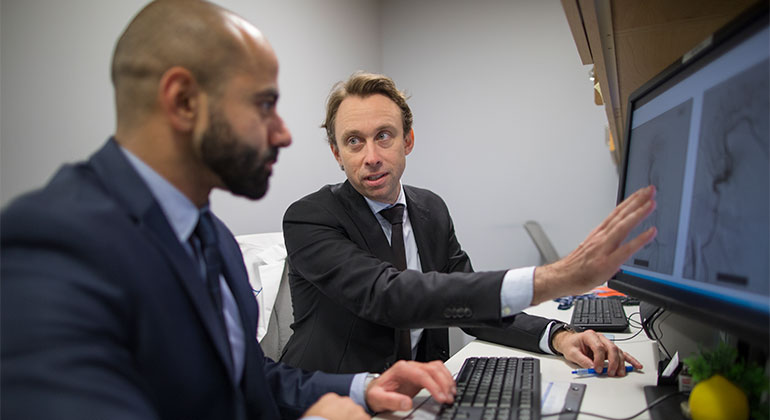
Spinal Conditions
At Mount Sinai, our team of interventional neuroradiologists is highly effective in reversing life-threatening conditions and relieving long-term pain caused by spinal malformations, spine nerve irritation, arthritis of the spine joints, vertebral compression fractures and certain kinds of bony tumors. We treat a wide range of spinal conditions. The most common are:
Spinal Malformations happen when the tiny blood vessels, called capillaries between the arteries and veins become tangled on, near, or in the spinal cord. These malformations may cause abrupt pain; progressive loss of strength or sensation; or bowel, bladder, or sexual dysfunction. We usually use magnetic resonance imaging spinal angiography to diagnose spinal malformations and to delineate the spinal cord vascular anatomy, which is essential for planning treatment. If left untreated, a spinal arteriovenous malformation can permanently damage your spinal cord by causing severe swelling of the cord or by rupture of the lesion.
Back pain can result from degenerative arthritis of the spine or when a herniated disc irritates one of the spinal nerves. This pain may be localized to the spine or may results in “referred” pain that is felt in the arms, legs or less commonly the torso.
Vertebral compression fractures result from trauma. Softening or weakening of bone due to osteoporosis or another underlying metabolic condition predisposes patients to fractures of the spine from little or minimal trauma. Patients with multiple myeloma or patients whose cancer has spread to the spine are also subject to vertebral compression fractures. The pain is often severe and debilitating and is readily treatable with minimally invasive techniques to stabilize the fracture and/or treat the tumor.
Treatment Options
Our multidisciplinary team of specialists, including neurointerventionalists, neurosurgeons, neurologists, and neurophysiologists, works together to create and carry out your individual treatment plan.
Spinal arteriovenous malformations (AVM) or fistulae (AVF) are evaluated with imaging that may include MRI and catheter angiography. These imaging techniques allow our specialists to develop a treatment plan, which may include a technique called embolization. This is where the blood supply to the lesion is permanently blocked preventing further supply to the lesion.
If you have back pain related to irritation of a spinal nerve or arthritis of the joints of the spine, we use both computer tomography (CT) and magnetic resonance imaging (MRI) to pinpoint the precise location of the irritated nerve, nerve root, or region of the spine. Following that a treatment plan can be developed which may involve very selective delivery of pain relieving medication to the region effected using advanced imaging guidance. The following procedures are available to treat pain related to irritation of a spinal nerve or degenerative arthritis of the spine.
- Epidural and selective transforaminal nerve root injections can relieve the pain and inflammation related to nerve irritation. We inject both an anesthetic and a steroid into the affected area.
- Medial branch block and facet joint injections can treat pain from facet degenerative disease or trauma. Once we identify the painful facet joint or the medial branch (nerve supply to facet joint), we inject a combination of anesthetics and steroids.
- Radiofrequency ablation often works for people who respond well to medial branch blocks. We place a probe at the location of the diseased facet joint nerves and send a strong radiofrequency pulse through the probe, destroying the nerve and providing significant lasting pain relief.
- Sacroiliac joint injections are effective when your sacroiliac joint, which connects the spine and pelvis, wears away, resulting in severe pain in that region and in your pelvis, lower back, groin, legs, or abdomen. We inject an anesthetic and a steroid directly into your sacroiliac joint. For both short- and long-term pain relief.
Vertebral compression fractures are initially managed with pain medication, bed rest, physical therapy and bracing. In some patients who have severe pain, where simple measures are not sufficient the following procedures are highly effective in releiving pain and restoring mobility:
- Vertebroplasty and kyphoplasty involve injecting a specially formulated medical cement directly into the damaged vertebrae to destroy painful nerve fibers and both strengthen and brace the fractured or diseased bone. In vertebroplasty, we use a needle to inject the cement. In kyphoplasty, prior to injecting the cement, a small balloon is used to create a cavity within the fractured bone to help restore loss of vertebral height that occurs with compression fractures. These are minimally invasive day procedures.
- Chemotherapy and/or radiation therapy are often effective along with vertebroplasty and kyphoplasty to stabilize bone that is diseased by cancer. We work closely with oncologists and orthopedists to coordinate this aspect of your care.